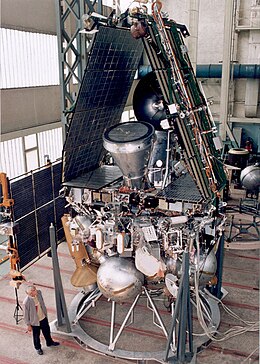 Mars 96 probe assembly | |
| Names | Mars-8 |
|---|---|
| Mission type | Mars Orbiter Lander Penetrators |
| Operator | Roscosmos |
| COSPAR ID | 1996-064A |
| SATCAT no. | 24656 |
| Mission duration | Failed to orbit |
| Spacecraft properties | |
| Spacecraft | Mars 96 |
| Manufacturer | NPO Lavochkin |
| Launch mass | 6,180 kg (13,620 lb) |
| Dry mass | 3,159 kg (6,964 lb) |
| Start of mission | |
| Launch date | 16 November 1996, 20:48:53 UTC |
| Rocket | Proton-K / D-2 |
| Launch site | Baikonur Cosmodrome, Site 200/39 |
| Contractor | Khrunichev State Research and Production Space Center |
| Entered service | Failed to orbit |
| End of mission | |
| Decay date | 17 November 1996 |
| Orbital parameters | |
| Reference system | Geocentric orbit |
| Regime | Low Earth orbit |
Mars 96 (sometimes called Mars-8) was a failed Mars mission launched in 1996 to investigate Mars by the Russian Space Forces and not directly related to the Soviet Mars probe program of the same name. After failure of the second fourth-stage burn, the probe assembly re-entered the Earth's atmosphere, breaking up over a 320 km (200 mi) long portion of the Pacific Ocean, Chile, and Bolivia.[1] The Mars 96 spacecraft was based on the Phobos probes launched to Mars in 1988. They were of a new design at the time and both ultimately failed. For the Mars 96 mission the designers believed they had corrected the flaws of the Phobos probes, but the value of their improvements was never demonstrated due to the destruction of the probe during the launch phase.
- ^ James Oberg (6 March 1999). "The probe that fell to Earth". New Scientist. Retrieved 9 September 2009.